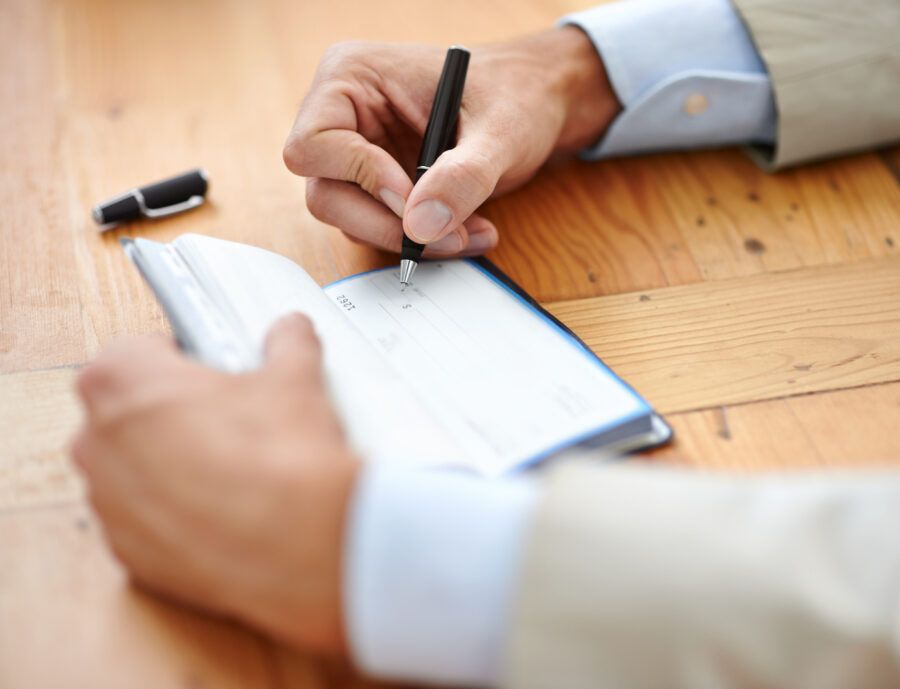In this article:
Check washing fraud is far from new, but a recent resurgence in the crime might have you rethinking when and how you send checks. The basic premise is simple: Someone steals a filled-out check, erases everything but the signature and then makes the check out to themselves. Unfortunately, the theft and forgery can quickly drain thousands of dollars from your account, and it might take months to get your money back. However, there are a few things you can do to protect yourself.
What Is Check Washing Fraud?
Check washing is one step in a chain of events that criminals use to steal money. The entire check fraud scheme generally works like this:
- Criminals steal checks from the mail. Someone might steal letters from your mailbox or blue U.S. Postal Service collection boxes looking for personal, business and government-issued checks. These thieves may be individuals acting on their own or part of a larger organized crime group.
- They wash the stolen checks. Thieves prepare and wash checks with specific chemicals to remove the payee information and amount, but keep the rest of the check's information and the signature. Or, the criminals might try to scratch off the existing name and amount.
- They write new information on the blank check. Once the check is washed and dried, criminals can write in any name and amount they want. They might turn a $50 check into a $5,000 check and can make it out to whomever they want.
- They deposit the check. The criminals can then try to deposit the check at a bank or ATM, use mobile deposit or go to a check cashing store. They might have accounts they opened using a fake identity. Or, they might recruit someone to be a money mule and deposit the check on their behalf, perhaps for a cut of the stolen amount.
- And then they withdraw the funds. Once the check clears, the criminals quickly withdraw cash from an ATM or transfer the money to an account they control to help hide the fund's illicit origins.
As with other schemes, the process is sometimes broken up among different criminals or groups. For example, some criminals might focus on stealing and washing checks, and then sell the washed checks on the dark web or messaging apps rather than cashing the check. Or, some criminals might focus on buying and depositing washed checks rather than stealing and washing them.
How to Avoid Check Washing Fraud
There are several things you can do if you're worried about your checks getting stolen, washed and used for check fraud.
- Use electronic bill pay and transfers. One of the best ways to avoid check washing fraud is to stop using checks. You might be able to sign up for free online bill pay services through your bank or credit union, or use your credit or debit card to pay bills online. Direct bank transfers or peer-to-peer payment apps could be a better option when sending money to friends or family.
- Use a black gel pen. If you are writing a check, gel pens might have ink that's harder for criminals to wash off. Some gel pens, such as Uni-Ball pens with Super Ink, even claim that their ink protects against fraud.
- Drop checks off at the post office. Minimize the likelihood that a thief will steal your check by putting it into the mail at the post office rather than leaving it in a blue USPS box. If you're mailing a check from your home, don't raise the flag on your mailbox—thieves may be on the lookout for these.
- Retrieve mail from your mailbox daily. You never know when a thief will try to steal your mail, so it's best to frequently check your mailbox. You can also sign up for Informed Delivery from the USPS to get an email with images of the letter-sized mail you should receive each day.
- Ask for a USPS mail hold when traveling. If you're going to be out of town, you can request a USPS mail hold, and the USPS will hold your mail for up to 30 days.
- Frequently review your checking account. Keep a close eye on your checking account and look for unusual or unexpected withdrawals.
You can also warn family members and friends who regularly send checks about the dangers of mail theft and the steps they can take to help avoid check washing fraud.
What to Do if Your Money Is Stolen
You should contact your bank immediately if you think someone has stolen one of your checks or your checkbook. The bank may be able to put a hold on the check to keep criminals from using it.
If it's too late and you've noticed someone has deposited a forged check, you should still contact your bank to report the fraud. You may need to also file a police report, and banks generally have to reimburse customers for forged checks. But there could also be a debate about which bank is liable, and some people have had the investigations and disputes drag on for months.
To escalate the situation, you could try reaching out to the bank's regulator. Use the search tool at HelpWithMyBank.gov for national banks and the links on that page to find the regulators for credit unions and state-chartered banks.
Also Monitor Your Credit for Identity Theft
Although check thieves focus on washing and using—or selling—checks, some can use the information from your mail to steal your identity as well. Regularly checking your credit or using a credit monitoring service with free alerts, like the one from Experian, can quickly warn you if someone tries to open a credit account using your information. Identity theft protection services can also look for your information in additional databases and offer financial and logistical help with identity restoration.

